History
 Georgia is a small nation that borders Russia, and in fact, was part of Russia at one time. The two nations had been at odds for a long time, and tempers just seemed to be simmering, with a deep heat that threatened to boil over into an all-out war. On August 8, 2008, the conflict finally hit the boiling point. What followed was a shooting war that while brief, was the most violent episode in a conflict that began more than a decade before.
Georgia is a small nation that borders Russia, and in fact, was part of Russia at one time. The two nations had been at odds for a long time, and tempers just seemed to be simmering, with a deep heat that threatened to boil over into an all-out war. On August 8, 2008, the conflict finally hit the boiling point. What followed was a shooting war that while brief, was the most violent episode in a conflict that began more than a decade before.
As the Union of Soviet Socialist Republics was breaking up in 1991, the nation of Georgia decided that it was time to declare their independence. A group of pro-Russian separatists decided that they were going to take control of two regions a short time later. The regions were composed of a combined 20 percent of Georgia’s territory, Abkhazia and South Ossetia. That, being unacceptable to Georgia, created a stalemate. In addition, in 2008, President George W Bush announced his support for Georgia’s and Ukraine’s membership in the North Atlantic Treaty Organization, something that should never have happened, and a move that Russia viewed as tantamount to putting a hostile military on its borders. I would have to agree with that assessment, and I think we are seeing the continued effects of that move to this day. I’m not saying that the people of Georgia and Ukraine are bad people, but the governments are questionable, causing Russia to take the steps it has taken.

With relations between the two nations already tense in 2008, and the aggressive nature of Vladimir Putin, who is in power in Russia, Georgian President Mikheil Saakashvili, declared his intent to bring Abkhazia and South Ossetia back under Georgian control. This didn’t go over very well. Putin and Saakashvili accused each other of acts of aggression throughout the spring and summer of 2008. On August 1st, South Ossetian troops violated the ceasefire by shelling Georgian villages. Sporadic fighting and shelling ensued over the coming days, until Saakashvili declared a ceasefire on August 7th. The separatists refused to honor the cease fire, so Georgia’s military launched an attack on Tskhinvali in South Ossetia. Russian troops had already illegally entered South Ossetia, and so they responded quickly to the Georgian attack. The fighting spilled over into Abkhazia when Georgian troops seized Tskhinvali. The initial Georgian advance was pushed back and within a few days Russia seized most of the disputed territory and was advancing into Georgia proper. The two sides agreed to a ceasefire in the early hours of August 13th. While the war was short lived, it was fierce. During the five-day conflict, 170 servicemen, 14 policemen, and 228 civilians from Georgia were killed and 1,747 wounded. In addition, 67 Russian servicemen were killed and 283 were wounded, and 365 South Ossetian servicemen and civilians (combined) were killed.

After the war, Russia formally recognized Abkhazia and South Ossetia as independent states, but stayed in occupation of them, in violation of the ceasefire. They took similar action concerning Ukraine in 2014, when they annexed the Crimean Peninsula, backing separatists in the west of the country. The Russo-Georgian War displaced an estimated 192,000 people, many of whom fled ethnic cleansing of Georgians in the separatist territories. The situation remained tense, and then once again came to a boiling point in 2022, as we have all seen.
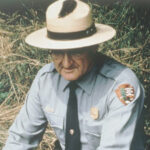 Most of us try really hard to avoid being struck by lightning…for obvious reasons, and I really don’t think anyone would ever enjoy setting a world record for the most time struck by lightning. Nevertheless, Roy Sullivan, a park ranger in Virginia for decades, spent a lot of time outdoors, a requirement of the job. During that time, Sullivan was struck by lightning multiple times. Sullivan, who holds the world record for being struck by lightning, was first hit in 1942…resulting in the loss of a big toe. The next occurrence was in 1969, during which he lost his eyebrows, and subsequent strikes in 1970, 1972, and 1973 caused burned hair and skin. Sullivan was hit twice more in 1976 and 1977. All seven strikes were documented by the superintendent of the Shenandoah National Park, R. Taylor Hoskins, and verified by doctors, making he claim to “fame” legitimate, and earning him a spot in the Guiness Book of World Records…a spot that he has held for 45 years. As I said, I don’t think anyone is really very interested in beating that record. Of that last strike, Sullivan relates that he was “fishing on Saturday morning, June 25, 1977, when lightning hit the top of his head, burning his hair, chest and stomach. He turned to his car when he spotted a black bear, trying to steal his trout. Sullivan summoned the strength to whack the bear with a stick. He’d later claim it was the twenty-second time he’d had to whack a black bear with a stick.” Sullivan’s long career as a park ranger was what put
Most of us try really hard to avoid being struck by lightning…for obvious reasons, and I really don’t think anyone would ever enjoy setting a world record for the most time struck by lightning. Nevertheless, Roy Sullivan, a park ranger in Virginia for decades, spent a lot of time outdoors, a requirement of the job. During that time, Sullivan was struck by lightning multiple times. Sullivan, who holds the world record for being struck by lightning, was first hit in 1942…resulting in the loss of a big toe. The next occurrence was in 1969, during which he lost his eyebrows, and subsequent strikes in 1970, 1972, and 1973 caused burned hair and skin. Sullivan was hit twice more in 1976 and 1977. All seven strikes were documented by the superintendent of the Shenandoah National Park, R. Taylor Hoskins, and verified by doctors, making he claim to “fame” legitimate, and earning him a spot in the Guiness Book of World Records…a spot that he has held for 45 years. As I said, I don’t think anyone is really very interested in beating that record. Of that last strike, Sullivan relates that he was “fishing on Saturday morning, June 25, 1977, when lightning hit the top of his head, burning his hair, chest and stomach. He turned to his car when he spotted a black bear, trying to steal his trout. Sullivan summoned the strength to whack the bear with a stick. He’d later claim it was the twenty-second time he’d had to whack a black bear with a stick.” Sullivan’s long career as a park ranger was what put 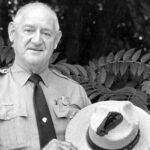 him in the path of the bears those 22 times. I’d say that is another record, I would not want to attempt to beat, not that it is in the Guiness Book of World Records. Nevertheless, I’ll leave that one right there.
him in the path of the bears those 22 times. I’d say that is another record, I would not want to attempt to beat, not that it is in the Guiness Book of World Records. Nevertheless, I’ll leave that one right there.
People who have struck by lightning will tell you things like your hair stands up on end, and that you need to get away from that area or hit the ground and stick your rear end in the air, which is supposedly the best place to take the hit, with the least amount of damage. Nevertheless, Sullivan described the moments before getting struck by lightning for Field and Stream, saying “You can smell sulfur in the air, and then your hair will stand on end, and then it’s going to get you. You don’t have time to do anything.” I don’t know if the people, who had time to get out of the area were, for some reason, less susceptible to lightning, or what caused them to be able to get away, but for some reason, Sullivan had no escape by the time these things happened. It makes he think he would have wanted to run for cover the minute he saw a dark cloud, but maybe he couldn’t really leave his post. Sullivan might have been struck by lightning eight times. You see, somewhere along the way, Sullivan earned the nickname “Human 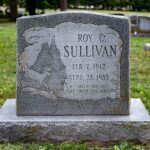 Lightning Rod,” something that upset him in his later years, because people avoided being in his presence…especially when a storm was brewing. After so many strikes, it would really be human nature to avoid him. Sullivan’s own wife was struck once too. She was hanging clothes in their back yard, and Roy was helping her at the time. For all we know, the bolt might have been aimed at him, and she got in the way.
Lightning Rod,” something that upset him in his later years, because people avoided being in his presence…especially when a storm was brewing. After so many strikes, it would really be human nature to avoid him. Sullivan’s own wife was struck once too. She was hanging clothes in their back yard, and Roy was helping her at the time. For all we know, the bolt might have been aimed at him, and she got in the way.
With all that going on in his life, you might expect that Sullivan would eventually have died as a result of lightning or the bears, but sadly, his death on September 28, 1983, was not from lightning or from a bear attack, but as a result of a self-inflicted gunshot to the head. Such a sad ending for a man who had “weathered” so much.
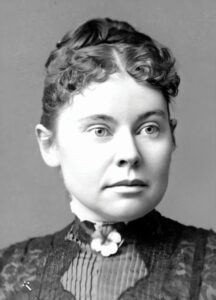
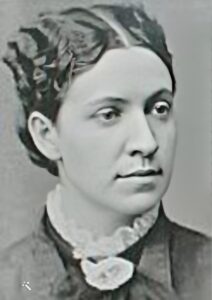 Lizzie Borden was a unique character for her era, in that the thing that most people remember about her was her arrest and trial for the axe murders of her father and stepmother in 1892. While many people believe she was guilty of the murders, she was actually acquitted in 1893. For whatever reason, the case against her was such that it could not be proven “without a shadow of a doubt,” which is the requirement for a conviction.
Lizzie Borden was a unique character for her era, in that the thing that most people remember about her was her arrest and trial for the axe murders of her father and stepmother in 1892. While many people believe she was guilty of the murders, she was actually acquitted in 1893. For whatever reason, the case against her was such that it could not be proven “without a shadow of a doubt,” which is the requirement for a conviction.
Lizzie Borden was born on July 19, 1860, in Fall River, Massachusetts. Lizzie Borden and her sister, Emma, were born to Andrew and Sarah Borden. Sarah Borden died a short time after Lizzie’s birth. The girls lived with their father, Andrew Borden who married a woman named Abby Durfee Gray, three years after Sarah’s passing. The relationship between the girls and their stepmother was not a close one, in fact, they greeted her as “Mrs. Borden” and worried that Abby Borden’s family sought to gain access to their father’s money. Emma was protective of her younger sister and, together, the two sisters helped to manage the rental properties owned by Andrew Borden. The family attended the Congregationalist Church, an institution in which Lizzie was particularly involved. The family lived well. Andrew Borden was successful enough in the fields of manufacturing and real estate development to support his wife and two daughters, Emma and Lizzie quite comfortably. He also employed servants to keep their home in order. Both Emma and Lizzie lived with their father and stepmother into adulthood.
On August 4, 1892, Andrew and Abby Borden were found murdered in their home. Of course, as is common, the family is questioned in these cases, and in the end, Lizzie was arrested and tried for the axe murders. It seems strange to me that after living with the couple for almost thirty years, Lizzie would suddenly decide that 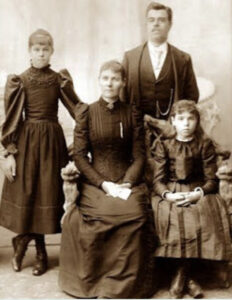 she didn’t need them anymore…especially since her dad was so financially successful, and his death could bring an end to that financial security. Nevertheless, it’s hard to say what can push someone over the edge. I guess the jury must have agreed with my own train of thought because Lizzie was found not guilty. Even with the trial and the trauma of all that happened, Lizzie continued to live in Fall River until her death, on June 1, 1927. The murders of her father and stepmother were never solved.
she didn’t need them anymore…especially since her dad was so financially successful, and his death could bring an end to that financial security. Nevertheless, it’s hard to say what can push someone over the edge. I guess the jury must have agreed with my own train of thought because Lizzie was found not guilty. Even with the trial and the trauma of all that happened, Lizzie continued to live in Fall River until her death, on June 1, 1927. The murders of her father and stepmother were never solved.
On the morning of August 4, 1892, Andrew and Abby Borden were murdered and mutilated in their Fall River home. It was Lizzie Borden who alerted the maid, Bridget, to her father’s dead body. He had been attacked and killed while sleeping on the sofa. A search of the home led to the discovery of the body of Abby Borden in an upstairs bedroom. Like her husband, Abby Borden was the victim of a brutal hatchet attack. The police were called to the scene of the murders, and they suspected Lizzie immediately. Nevertheless, she was not taken into custody at that time. Her sister, Emma, was out of town at the time and was never a suspect. Apparently, Lizzie burned a dress during the week between the murders and her arrest. She said the dress was stained with paint, so it needed to be burned. The prosecutors believed that the dress was stained with blood, and that Lizzie had burned it to cover up her crime, which is why she was indicted on December 2, 1892. Her widely publicized trial began the following June in New Bedford. Borden did not take the stand in her own defense and her inquest testimony was not admitted into evidence. The testimony provided by others proved inconclusive. On June 20, 1893, Lizzie Borden was acquitted of the murders, and no one else was ever charged with the crimes.
Following the deaths of their dad and stepmom, Lizzie and Emma Borden inherited a significant portion of their father’s estate. They purchased a new home together and lived together for the following decade. Although she was acquitted, Lizzie was considered guilty by many of her neighbors and her reputation was further tarnished when she was accused of shoplifting in 1897. Then in 1905, Emma Borden abruptly moved out of the house that she shared with her sister. While no one ever knew what happened between the sisters, they never spoke 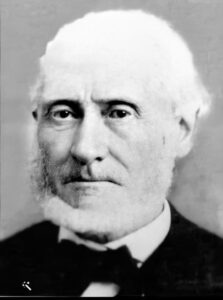
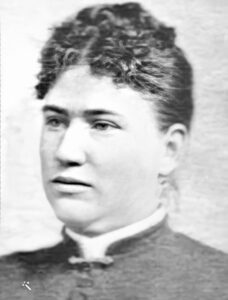 again. Speculation was that Emma may have been uncomfortable with Lizzie’s close friendship with another woman, Nance O’Neil, but she never really said that was the case. Emma’s silence on the matter fueled speculation that she learned new details about the murders of her father and stepmother. The household staff were tight-lipped on the matter and didn’t even offer additional information on the rift following Lizzie’s death. Lizzie Borden died of pneumonia in Fall River, Massachusetts, on June 1, 1927. Strangely, the day Lizzie died, Emma had an accident and broke her hip. She died due to chronic nephritis, 9 days later, on June 10, 1927. The Borden sisters, along with the rest of the family, are buried side by side at the family plot in Oak Grove Cemetery in Fall River.
again. Speculation was that Emma may have been uncomfortable with Lizzie’s close friendship with another woman, Nance O’Neil, but she never really said that was the case. Emma’s silence on the matter fueled speculation that she learned new details about the murders of her father and stepmother. The household staff were tight-lipped on the matter and didn’t even offer additional information on the rift following Lizzie’s death. Lizzie Borden died of pneumonia in Fall River, Massachusetts, on June 1, 1927. Strangely, the day Lizzie died, Emma had an accident and broke her hip. She died due to chronic nephritis, 9 days later, on June 10, 1927. The Borden sisters, along with the rest of the family, are buried side by side at the family plot in Oak Grove Cemetery in Fall River.
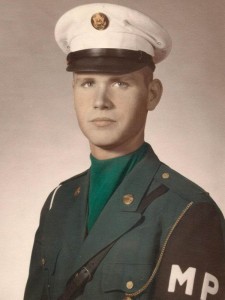
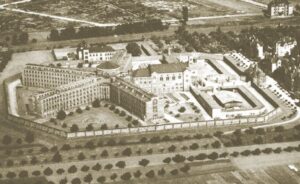 My brother-in-law, LJ Cook was an MP in the Army from 1968 to 1971, which was the Vietnam Era. For a long time, that was all I knew about his time of service. Today, that has all changed. I think I thought of MPs as maybe handling the disobedient military personnel, maybe like the movie, “Stripes” or the show, “MASH,” but movies rarely tell the whole story on these things. LJ went through basic training in Fort Ord, located in the Monterey Bay area of California. Following his basic training, LJ was sent to MP school at Fort Gordon located southwest of Atlanta, Georgia. Following his MP training, LJ flew into Frankfort, Germany, and then on to Mannheim, Germany, where he would spend the remainder of his military service as an MP at the Mannheim Prison.
My brother-in-law, LJ Cook was an MP in the Army from 1968 to 1971, which was the Vietnam Era. For a long time, that was all I knew about his time of service. Today, that has all changed. I think I thought of MPs as maybe handling the disobedient military personnel, maybe like the movie, “Stripes” or the show, “MASH,” but movies rarely tell the whole story on these things. LJ went through basic training in Fort Ord, located in the Monterey Bay area of California. Following his basic training, LJ was sent to MP school at Fort Gordon located southwest of Atlanta, Georgia. Following his MP training, LJ flew into Frankfort, Germany, and then on to Mannheim, Germany, where he would spend the remainder of his military service as an MP at the Mannheim Prison.
Construction on Mannheim Prison was started in 1905 and it first opened for use in 1909. It was a Third Reich prison until after World War II. Then it was used for United States military purposes during the Vietnam War. The prison included a separate hospital building, which until 1945 was used to treat ill prisoners throughout the region. The prison was considered modern for the time, with each cell having running water with a toilet and a washbasin, central heating and electric light. As with all prisons in Third Reich Germany, Mannheim Prison was used to incarcerate standard criminal convicts as well as political prisoners.
LJ was a Maximum Confinement Section Chief during his time at Mannheim Prison. The correctional officers lived in the barracks on site during their off time. LJ was part of the 77th MP Company, which at that time was the biggest company in army. The prison also had two chapels, two mess halls, and it was a large enough place that LJ didn’t know everyone stationed there…even after three years. When an MP first arrives at Mannheim Prison, they are settled into the squad bay in the attic of the barracks. This is really temporary housing until they can be officially assigned. Most of the rooms in the main barracks (specifically for the Non-NCO personnel) have four men to a barracks. The NCOs had two men to a room. And the higher-ranking officers had a private room. Lynn’s highest rank was that of Acting E7, but his permanent rank was Seargent. He could have been given the permanent rank of E7, if he had wanted to re-enlist for six more years. He did not. He would have also been sent to Vietnam had he re-enlisted.
During his time at Mannheim Prison, LJ saw three or four prison riots, all of which the MPs squashed. The prisoners at Mannheim Prison were American GIs in prison for everything from being AWOL to murder. Of course, riots happened when the prisoners overpowered a guard. That seems like an unlikely possibility, but the prison, with four blocks, A, B, C, and D, with each block having 8 cells, each holding 30 to 40 prisoners. Cells were made of steel bars so, no privacy. A guard was sometimes in the cell with the men, and you just didn’t take a gun in there, on the off chance that a prisoner could take it from you. The guards were armed with night sticks, as their only weapon. During the riots, while LJ was there, no guards were killed, but there were a number of incidences in which guards were beaten. LJ was once hit in the head by a boot thrown at him by a prisoner. LJ had to hit the man with his night stick. In defending himself, LJ dislocated the man’s shoulder and broke his collar bone. Needless to say, the man never threw a boot at LJ again.
Another part of LJ’s job was to make arrangements for shipments of prisoners from Mannheim Prison to Leavenworth Prison, in northeastern Kansas. Leavenworth is now a medium security US penitentiary. LJ made eight trips across the Atlantic with shipments of prisoners. One onboard, LJ was in charge of everything on the plane. The prisoners were not handcuffed or otherwise restrained, and there were no bars or cages between prisoners and guards. Sometimes the whole plane was full of guards and prisoners. When the made fueling stops, the prisoners had to get off. The airports had to be notified upon landing so they could bring out extra security to prevent escape. The prisoners thought LJ was crazy. He told them that he would take action is they tried to escape, and that he was a bad shot. He said that while trying to “wound” escaping prisoners, but that he almost aways missed and hit the prisoner in the back of the head. Needless to say, LJ never lost a prisoner. After the guards transported prisoners, they got two weeks leave, so he would usually head home to Lovell, Wyoming for a home visit. The military license said that he had said “no time or mileage limitation.” That meant that he could go wherever he wanted, so if he was not going home, he might get a taxi to a train station, and then head out to wherever he wanted to see at the time. He also had a friend who was a warrant officer, who piloted a Huey Helicopter. On days off, they would jump in the Huey and go all over Europe and even northern Africa. The “normal work week” in the Army was a “twelve day” week. The men had three days on day shift 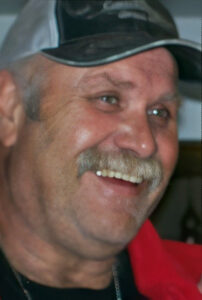
 followed by 24 hours off. Then they had three days on swing shift followed by 24 hours off, and finally three days on night shift followed by 24 hours off. It gave them time to have some R and R every few days. The two weeks for leave were the normal 14 days. LJ was honorably discharged from the Army in 1971. His training would help him in his career as a Deputy Sheriff in Casper, Wyoming. I would like to thank my brother-in-law, LJ Cook for his service to his country. Today is LJ’s birthday. Happy birthday LJ!! Have a great day!! We love you!!
followed by 24 hours off. Then they had three days on swing shift followed by 24 hours off, and finally three days on night shift followed by 24 hours off. It gave them time to have some R and R every few days. The two weeks for leave were the normal 14 days. LJ was honorably discharged from the Army in 1971. His training would help him in his career as a Deputy Sheriff in Casper, Wyoming. I would like to thank my brother-in-law, LJ Cook for his service to his country. Today is LJ’s birthday. Happy birthday LJ!! Have a great day!! We love you!!
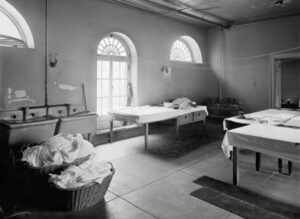
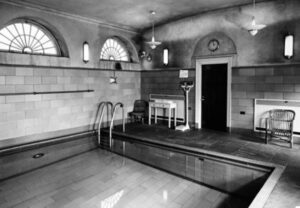 Construction began on the White House on October 13, 1792, and was finally finished on November 1, 1800. Construction was slower in those days, because they didn’t have the equipment we have today. The current White House has 132 rooms. The original White House had 100 rooms. The White House has 54,900 square feet. The White House sits on 18 acres of land. It all it is an impressive building, but there is more to it than just that.
Construction began on the White House on October 13, 1792, and was finally finished on November 1, 1800. Construction was slower in those days, because they didn’t have the equipment we have today. The current White House has 132 rooms. The original White House had 100 rooms. The White House has 54,900 square feet. The White House sits on 18 acres of land. It all it is an impressive building, but there is more to it than just that.
There have been a number of rooms that began as one thing, only to become something else later on. One of the rooms that has had a couple of identities is the Press Briefing Room. These days it is the James S. Brady Press Briefing Room. It was so named after White House Press Secretary James Brady, who was shot and permanently disabled during the assassination attempt on President Reagan. That room, located in the West Wing of the White House was not always such a necessary room, mostly because press briefings are really more of a modern-day thing. The room has always existed, however. In 1909, it was the White House laundry, and during President Truman’s time in office (April 12, 1945 – January 20,1953) it was the White House pool.
By 1950, the White House was 150 years old and in a serious state of disrepair. In order to make is inhabitable 
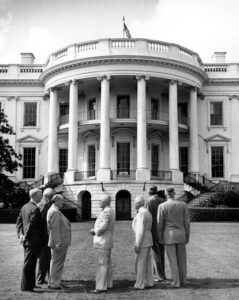 again, the entire building was gutted and rebuilt to make it more stable. It also seemed like a good time to improve on its design, so some improvements and additions were made. White House architect Lorenzo Simmons Winslow designed and built an air raid shelter under the East Terrace on the orders of naval aide Rear Admiral Robert Dennison. There had been a bomb shelter before, but it was built in 1942 and with the invention of the atomic bomb, the old shelter was not strong enough to withstand such an assault. Because little research had been conducted into how to withstand such an assault, construction of the shelter took more than two years and required the removal of the East Terrace entirely. Unfortunately, the 1952 shelter was rendered obsolete when the first test produced a force of 10.4 million tons. This shelter was designed to withstand a force of only 30,000 tons, so this would never work.
again, the entire building was gutted and rebuilt to make it more stable. It also seemed like a good time to improve on its design, so some improvements and additions were made. White House architect Lorenzo Simmons Winslow designed and built an air raid shelter under the East Terrace on the orders of naval aide Rear Admiral Robert Dennison. There had been a bomb shelter before, but it was built in 1942 and with the invention of the atomic bomb, the old shelter was not strong enough to withstand such an assault. Because little research had been conducted into how to withstand such an assault, construction of the shelter took more than two years and required the removal of the East Terrace entirely. Unfortunately, the 1952 shelter was rendered obsolete when the first test produced a force of 10.4 million tons. This shelter was designed to withstand a force of only 30,000 tons, so this would never work.
In addition to the new nuclear shelter, a tunnel was added. These days those tunnels are big in the news, but back then, they were probably a little-known addition. This reinforced concrete channel ran from the West Wing to the East Wing. Though not enough to stop a nuclear incident itself, the tunnel allowed quick passage from one end of the White House to the other, as well as access to the new air raid shelter. The presence of the tunnel demonstrates just how concerned the Truman White House was about securing itself against air assaults at that volatile time in history. That first tunnel inside the White House isn’t the only underground feature. In 1987, a second tunnel was built under the name Project ZP. That tunnel, accessible from a secret passage 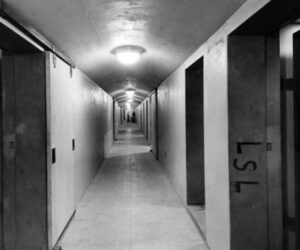
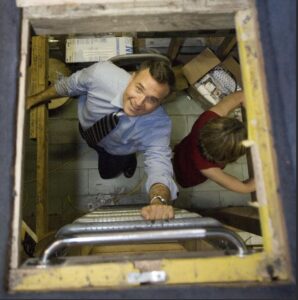 within the Oval Office, leads to the basement of the East Wing and on to the Treasury Building. Its construction, which was largely secret, created a large sinkhole in the White House rose garden. The tunnel was reportedly built to quickly get the president out of the office during an incursion, but it was also used at least once to sneak former president Richard Nixon into a foreign policy meeting. I’m sure there are other changes to the White House, that we are not privy to, and may never know, because there are always secrets in this kind of building.
within the Oval Office, leads to the basement of the East Wing and on to the Treasury Building. Its construction, which was largely secret, created a large sinkhole in the White House rose garden. The tunnel was reportedly built to quickly get the president out of the office during an incursion, but it was also used at least once to sneak former president Richard Nixon into a foreign policy meeting. I’m sure there are other changes to the White House, that we are not privy to, and may never know, because there are always secrets in this kind of building.
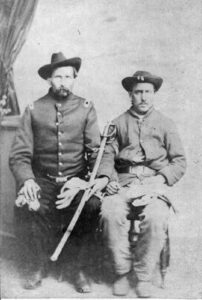
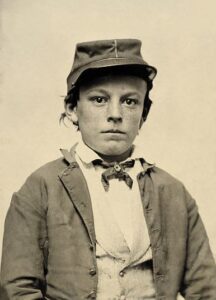 Anyone who has studied history in school knows about the Civil War. It was, of course, fought over slavery. The South wanted to keep the slaves and the North wanted to free the slaves. The Civil War was unique in another way too. Most wars are fought with soldiers who are rough and tough, ready to take on the elements, and battle to the death for their cause. The Civil War was that too, but the men of the South during the Civil War Era, were part of an era of the southern belles and southern gentlemen. This was an era when a type of lifestyle was borrowed from the English countryside, and basically transplanted into the American south. The lifestyle included a glorification of elegant horse riding, hunting, and of course, etiquette. This era and the people in it felt like there was a proper way to do things and that a certain level of decorum must be kept at all costs, in order to preserve their way of life.
Anyone who has studied history in school knows about the Civil War. It was, of course, fought over slavery. The South wanted to keep the slaves and the North wanted to free the slaves. The Civil War was unique in another way too. Most wars are fought with soldiers who are rough and tough, ready to take on the elements, and battle to the death for their cause. The Civil War was that too, but the men of the South during the Civil War Era, were part of an era of the southern belles and southern gentlemen. This was an era when a type of lifestyle was borrowed from the English countryside, and basically transplanted into the American south. The lifestyle included a glorification of elegant horse riding, hunting, and of course, etiquette. This era and the people in it felt like there was a proper way to do things and that a certain level of decorum must be kept at all costs, in order to preserve their way of life.
Tobacco played the central role in defining social class, local politics, and the labor system. In fact, it shaped the entire life of the region, and in doing so, actually shaped the Civil War. While the Civil War was a war, somehow the men of the South who fought in it felt like it needed to have that high level of decorum and decency. Tradition needed to be kept and carried on and while they knew that they were fighting a war, I’m not entirely sure that they understand that there would be, by necessity, loss of life and loss of that decorum and etiquette. For the men of the South especially, the Civil War was one of the most devastating events to challenge their way of life. This was also the most devastating event ever to occur on North American soil. While the loss of life was great, and in fact the Civil War caused more Americans to lose their lives than both World War I and World War II combined, the people of the South lost much of that “British Countryside” lifestyle that they thought so essential…and afterward, they didn’t quite know how to recover from that. The Confederate Army wanted to separate from the Union and maintain slavery, and the fight to combat that notion didn’t end until 1865. The differing ideas were a cause for rift long after the war was over.
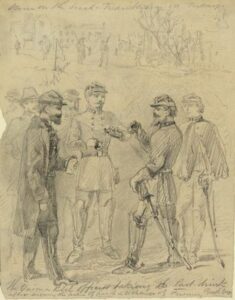
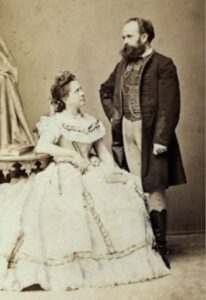 Nevertheless, despite the high stakes, the American soldiers from both sides still had several unofficial truces. Wars are usually long and tedious, and sometimes the men just needed to stop the fighting for a short time and try to be human again. Although these unofficial truces or ceasefires were usually frowned upon by military superiors, the men on either side would frequently call truces at the frontlines so Union and Confederate soldiers could chat, share information, and trade smokes. Imagine that…as the fighting is heavy, someone yells, “Wait…Smoke Break!!” Then both sides would stop shooting, walk out to the middle of te battlefield, and everyone would light a cigarette. I’m sure that’s not exactly how it happened, but they did actually hold such unofficial truces at times.
Nevertheless, despite the high stakes, the American soldiers from both sides still had several unofficial truces. Wars are usually long and tedious, and sometimes the men just needed to stop the fighting for a short time and try to be human again. Although these unofficial truces or ceasefires were usually frowned upon by military superiors, the men on either side would frequently call truces at the frontlines so Union and Confederate soldiers could chat, share information, and trade smokes. Imagine that…as the fighting is heavy, someone yells, “Wait…Smoke Break!!” Then both sides would stop shooting, walk out to the middle of te battlefield, and everyone would light a cigarette. I’m sure that’s not exactly how it happened, but they did actually hold such unofficial truces at times.

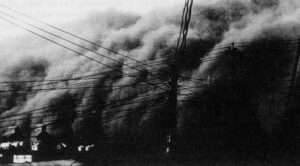 No matter where you live, I’m sure you have had encounters with grasshoppers. They are an unfortunate fact of life in this world. Some years are worse than others, and some areas are worse than others too. There are a few facts about grasshoppers that I didn’t know about, and some I did. Unfortunately, there are no chemical pesticides to control grasshoppers, but since cool, moist conditions slow them down and encourage the growth of fungi (which cause disease in grasshoppers), keeping plant beds moist and well irrigated may help ward them off. To protect small areas, try using a sticky paper or screening. Most of us find that in dry hot years, the grasshoppers make us as miserable as the heat. Never was that more evident than on July 26, 1931, when a swarm of grasshoppers descended on crops throughout America’s heartland, devastating millions of acres. Iowa, Nebraska, and South Dakota were already suffering from a bad drought that brought severe damage to the crops in the region. The grasshoppers really just finished them off.
No matter where you live, I’m sure you have had encounters with grasshoppers. They are an unfortunate fact of life in this world. Some years are worse than others, and some areas are worse than others too. There are a few facts about grasshoppers that I didn’t know about, and some I did. Unfortunately, there are no chemical pesticides to control grasshoppers, but since cool, moist conditions slow them down and encourage the growth of fungi (which cause disease in grasshoppers), keeping plant beds moist and well irrigated may help ward them off. To protect small areas, try using a sticky paper or screening. Most of us find that in dry hot years, the grasshoppers make us as miserable as the heat. Never was that more evident than on July 26, 1931, when a swarm of grasshoppers descended on crops throughout America’s heartland, devastating millions of acres. Iowa, Nebraska, and South Dakota were already suffering from a bad drought that brought severe damage to the crops in the region. The grasshoppers really just finished them off.
Anyone who has grown a garden, crops, trees, and even grass, have struggled to prevent insects from eating their crops or plants. Locusts and grasshoppers, which are insect cousins, are among the most feared pests. If the conditions are right, their populations can suddenly explode, and while just their presence is enough to make most people’s skin crawl, the speed with which they are able to eat through a field of crops is impossible to comprehend, unless they have witnessed it for themselves. A plague of these insects occurs when drought conditions cause their populations to suddenly explode. The egg pods don’t do well in wet conditions, so when the soil is very dry, swarms can develop. “They explode from beneath your feet. There’s sort of a rolling wave that forms out in front of you. They hit up against your body and cling against your clothes. It’s almost like being immersed in a gigantic living being,” says Professor Jeff Lockwood of Wyoming.
The swarm in July of 1931 was so thick that it actually blocked out the sun. The grasshoppers had to be scooped up with a shovel. They ate the cornstalks down to the ground, leaving just stubs, and they ate 
 everything in the fields, down to the bare ground. Thankfully, the United States hasn’t seen swarms since the early 1930s. Many other areas of the world are not so fortunate. North Africa and parts of the Middle East continue to experience problems with insect swarms. In fact, the swarms in some of those areas have involved as many as a billion bugs. I don’t know about you, but now my skin is really crawling. Eeeeeeewwwwwwww!!
everything in the fields, down to the bare ground. Thankfully, the United States hasn’t seen swarms since the early 1930s. Many other areas of the world are not so fortunate. North Africa and parts of the Middle East continue to experience problems with insect swarms. In fact, the swarms in some of those areas have involved as many as a billion bugs. I don’t know about you, but now my skin is really crawling. Eeeeeeewwwwwwww!!
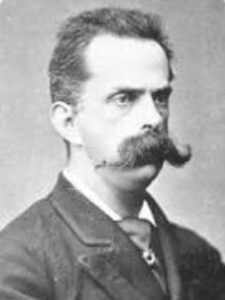 Each year, approximately 40 million lightning strikes hit the ground in the United States, with Tampa, Florida having the most, and Florida being listed as the Lightning Capital of the United States. While Florida is known as the Sunshine State, it is notorious for thunderstorms, lightning strikes and fatalities. On average, Florida has 3,500 cloud to ground lightning flashes per day and 1.2 million flashes per year. Nevertheless, the odds of a human being struck by lightning in a given year are less than one in a million, and strangely, almost 90% of all lightning strike victims survive. The odds of being struck multiple times is even less, with the record being seven times in one lifetime. According to the National Weather Service, lightning causes an average of 62 deaths and 300 injuries in the United States each year. People can be at greater risk for being struck if they participate in outdoor recreational activities or working outside. Regional and seasonal differences can also increase the risk of being struck by lightning. Being outdoors in a lightning storm is certainly not a good idea.
Each year, approximately 40 million lightning strikes hit the ground in the United States, with Tampa, Florida having the most, and Florida being listed as the Lightning Capital of the United States. While Florida is known as the Sunshine State, it is notorious for thunderstorms, lightning strikes and fatalities. On average, Florida has 3,500 cloud to ground lightning flashes per day and 1.2 million flashes per year. Nevertheless, the odds of a human being struck by lightning in a given year are less than one in a million, and strangely, almost 90% of all lightning strike victims survive. The odds of being struck multiple times is even less, with the record being seven times in one lifetime. According to the National Weather Service, lightning causes an average of 62 deaths and 300 injuries in the United States each year. People can be at greater risk for being struck if they participate in outdoor recreational activities or working outside. Regional and seasonal differences can also increase the risk of being struck by lightning. Being outdoors in a lightning storm is certainly not a good idea.
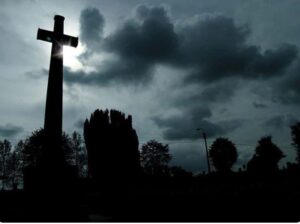
Lightning strikes to humans have been going on as long as times and lightning strikes have been going on. We just hear about them more today than in the distant past. Rarely, humans are struck by lightning, and even with the record of known strikes to humans in one lifetime being seven, it is still a very rare phenomenon. The first time Major Walter Summerford, an Englishman, was said to have been struck by lightning was in 1918 on a World War I battlefield. He was reportedly riding a horse at the time and, while the animal died, Summerford was only temporarily incapacitated by the strike. It’s possible the horse took the bulk of the hit, because Summerford’s feet were not on the ground, meaning that it traveled through Summerford, through the horse, and then on into the ground. That is the nature of lightning. It travels through something with electricity (which humans have, by the way) and then into the ground. So unfortunately, the horse became a part of the connection and actually finished the connection…costing the horse its life. Sad, for sure, but the horse saved the life of its rider.
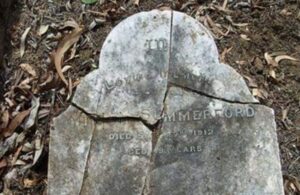
Summerford’s documented additional strikes included two more times…in 1924 and 1930. Then to make him even more unique, Summerford was technically struck after he had died. It happened that two years after he was buried in Vancouver, Canada, a lightning storm went through the area, and lightning actually struck his gravestone in 1936. The bolt was packed with so much power, that Summerford’s gravestone was completely destroyed by that fourth lightning strike. Now that’s got to be the most unique human/lightning encounter story in history.

 Neil Armstrong made history on July 20, 1969, when he became the first person to step on the moon. That is something we all have known about for a very long time. What we didn’t know about was that the Wright Brothers also made history on the moon. You might wonder how that could be, considering the fact that Orville and Wilber Wright died in 1948 and 1912, respectively. With that many years between their time and the 1969 moon landing, how could the Wright brothers possibly land on the moon. Well, it was simple really. As part of the mission, Armstrong and his team carried small bags of belongings called personal preference kits.
Neil Armstrong made history on July 20, 1969, when he became the first person to step on the moon. That is something we all have known about for a very long time. What we didn’t know about was that the Wright Brothers also made history on the moon. You might wonder how that could be, considering the fact that Orville and Wilber Wright died in 1948 and 1912, respectively. With that many years between their time and the 1969 moon landing, how could the Wright brothers possibly land on the moon. Well, it was simple really. As part of the mission, Armstrong and his team carried small bags of belongings called personal preference kits.
The men were supposed to choose things that had meaning to them and maybe even to the mission they were on. In Armstrong’s bag were souvenirs of another important aircraft… believe it or not, they were parts of the fabric and propeller from the Wright Flyer, flown by Armstrong’s fellow Ohioans, Wilbur and Orville Wright, on December 17, 1903. He must have felt a connection to them since all three of them were from Ohio. Some of those souvenirs remained with Armstrong after the flight to the moon, while some of the others went to the Smithsonian Institution.
In an interesting sidenote, another swatch of fabric from the Wright Flyer went with John Glenn, when he went into orbit aboard the space shuttle Discovery in 1998, and a postage-stamp-size piece has gone to Mars aboard the Ingenuity helicopter. It makes sense that the men who first made flight possible, should somehow have a place in what would have been the future of flight for them, if they were still alive. The Wright brothers started something with that first plane, and it wasn’t just flight. Without that first flight, space travel would never have been possible. They started the ball rolling on an amazing future of space exploration. What mor fitting tribute could there be that to take part of that first plane into space and allow it to land on the moon, mars, or just to be in flight in space at all.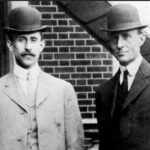
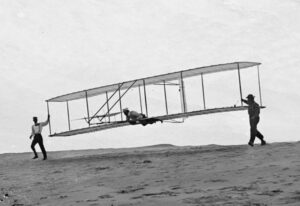
Bringing the Wright brothers into space by proxy was an amazing feat, but there was one other thing that I found odd anyway. When they mission returned home, they actually had to go through customs. That whole thought made me laugh. I mean…what did they think was going to be “smuggled” in, anyway? Nevertheless, going through customs was a requirement, so customs it was.
 My dad, Allen Spencer, went to work for Douglas Aircraft Company on May 19, 1942. He was a young man of just 18 years. Dad wasn’t with Douglas Aircraft Company for very long, because of World War II, and his enlistment in the Army Air Force on March 12, 1943. Nevertheless, the job my dad had while he was at Douglas Aircraft Company would play a big part in his future military assignment as a flight engineer on a B-17 Bomber during World War II, stationed at RAF Great Ashfield in Suffolk, England. Because of Dad’s job there, I have always had an interest in Douglas Aircraft Company.
My dad, Allen Spencer, went to work for Douglas Aircraft Company on May 19, 1942. He was a young man of just 18 years. Dad wasn’t with Douglas Aircraft Company for very long, because of World War II, and his enlistment in the Army Air Force on March 12, 1943. Nevertheless, the job my dad had while he was at Douglas Aircraft Company would play a big part in his future military assignment as a flight engineer on a B-17 Bomber during World War II, stationed at RAF Great Ashfield in Suffolk, England. Because of Dad’s job there, I have always had an interest in Douglas Aircraft Company.
While people might think they don’t know much about Douglas Aircraft Company, they really do, just under a different name. The Douglas Aircraft Company was an American aerospace manufacturer based in Southern California. It was founded in 1921 by Donald Wills Douglas Sr and later merged with McDonnell Aircraft in 1967 to form McDonnell Douglas. With that merger, Douglas Aircraft Company ceased to exist. The name McDonnell Douglas might be a bit more familiar to people, but it was really when McDonnell Douglas merged with Boeing in 1997 that the company became a household name. Everyone has heard of Boeing Aircraft Company.
While Douglas Aircraft Company no longer exists, they made great strides in the aerospace industry during their time in business. One early claim to fame was the first circumnavigation of the world by air in Douglas airplanes in 1924. That was just 21 years after the first powered flight, taken by the Wright Brothers. That may sound like a long time, but to go from the rickety-looking plane the Wright Brothers flew, to something that was 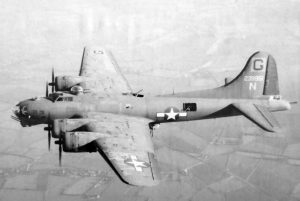 capable of making the flight around the world in just 21 years is truly outstanding. The circumnavigation mission was first presented to Douglas Aircraft Company in 1923, when the US Army Air Service, interested in carrying out a mission to circumnavigate the Earth for the first time by aircraft, approached Douglas Aircraft Company to present it to them. The mission was called “World Flight.” Donald Douglas proposed a modified Douglas DT to meet the Army’s needs. The two-place, open cockpit DT biplane torpedo bomber had previously been produced for the US Navy. The DTs were taken from the assembly lines at the company’s manufacturing plants in Rock Island, Illinois, and Dayton, Ohio, to be modified.
capable of making the flight around the world in just 21 years is truly outstanding. The circumnavigation mission was first presented to Douglas Aircraft Company in 1923, when the US Army Air Service, interested in carrying out a mission to circumnavigate the Earth for the first time by aircraft, approached Douglas Aircraft Company to present it to them. The mission was called “World Flight.” Donald Douglas proposed a modified Douglas DT to meet the Army’s needs. The two-place, open cockpit DT biplane torpedo bomber had previously been produced for the US Navy. The DTs were taken from the assembly lines at the company’s manufacturing plants in Rock Island, Illinois, and Dayton, Ohio, to be modified.
Four of these modified aircraft left Seattle, Washington, on April 6, 1924, flying west, and two of these returned there on September 28 to great fanfare. Unfortunately, one plane had been lost under fog conditions, and another was forced down over the Atlantic and sank. The DWC prototype was then rechristened and joined the other two in completing the North American leg of the flight. With the success of this flight, the Army Air Service ordered six similar aircraft as observation aircraft.
In 1934, Douglas produced a commercial twin-engined transport plane, the Douglas DC-2, which was followed by the famous DC-3 in 1936. The wide range of aircraft produced by Douglas included airliners, light and medium bombers, fighter aircraft, transports, reconnaissance aircraft, and experimental aircraft. While these were all important types of aircraft, it would really be the work they did during World War II, that really put  them on the map in my opinion. With so many young men heading off to war, the women really stepped up at this time and built many of the World War II planes. During that time, Douglas joined the BVD (Boeing-Vega-Douglas) consortium to produce the B-17 Flying Fortress. As far as I’m concerned, that was one of the greatest planes every produced. I suppose that sounds odd, considering that it was so long ago, but for its time, the B-17 was and really still is legendary. And while I don’t know if my dad had a part in building the B-17 Bomber, I know that he repaired them and knew them inside and out. I am proud of the work my dad did on the airplanes he helped to build, and proud of his time with Douglas Aircraft Company.
them on the map in my opinion. With so many young men heading off to war, the women really stepped up at this time and built many of the World War II planes. During that time, Douglas joined the BVD (Boeing-Vega-Douglas) consortium to produce the B-17 Flying Fortress. As far as I’m concerned, that was one of the greatest planes every produced. I suppose that sounds odd, considering that it was so long ago, but for its time, the B-17 was and really still is legendary. And while I don’t know if my dad had a part in building the B-17 Bomber, I know that he repaired them and knew them inside and out. I am proud of the work my dad did on the airplanes he helped to build, and proud of his time with Douglas Aircraft Company.

